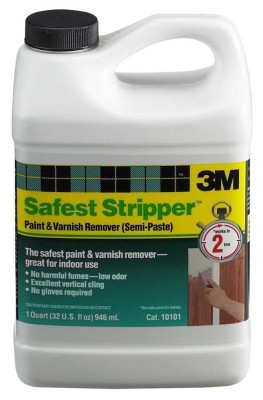Weeds
You have no doubt heard the old aphorism that, “A weed is just a flower in the wrong place.” The same might be said for commercial products in the marketplace, that they are sometimes useful but for different (read: wrong) things. For example, for years the family who owned the hardware store I patronized were uncertain what I did for a living, they only knew from our conversations that I bought products from them and used them (successfully) for unintended purposes. This adaptability is only one of the reasons why comprehension of materials science is fundamental to craftsmanship.

Of the products in my studio, perhaps the best that fits the “weeds” description — right product, wrong use — is Safest Stripper from 3M. It was/is marketed as a “environmentally friendly” general use paint and varnish remover, and when it performed poorly in the shops of antique restorers it got a bad reputation, at least in my circles. Perhaps unbeknownst to the 3M marketers, and certainly in the experience of the antique restorers using it, Safest Strippers is certainly not a high performance general purpose stripper.
But, it has a unique advantage in the shop that I find irreplaceable.
This usefulness is based on the original formulation and purpose for Safest Stripper. As I recall the history, Safest Stripper emerged from the world of aqueous solutions of dibasic esters (DBEs) which work gangbusters on many catalyzed coatings, airplane and auto paint in particular (I vaguely remember a conversation at a meeting of the American Federation of Societies for Coatings Technology that DBE solutions were created specifically for the catalyzed paint Imron, but that conversation was a long time ago). In my experience it also works pretty well on polyurinate, some polyesters, alkyds, and acrylics, somewhat less well on cellulose nitrate. Conversely, it has almost zero effect on natural resin coatings and natural oleoresinous coatings. Dealing with these latter two classes of paints and varnishes happens to be a huge component of antique restoration, so its ineffectiveness on them explains its unpopularity with many restorers.
I found that the primary feature, affinity for catalyzed and synthetic materials while leaving alone many older traditional coatings, along with the near-zero volatility of DBE solutions, makes Safest Stripper an absolutely perfect fit for those times when I need to safely remove, in particular, aged white and yellow glues that have been slathered on many a bad repair attempt.
That makes Safest Stripper an irreplaceable high-performance tool in my kit.
In a couple days I will recount how I use it in projects, with a photo montage of procedures and results.



Join the Conversation!